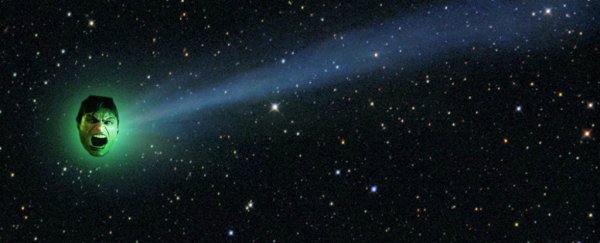Aim your binoculars to the sky tonight, because we're about to be visited by the remnants of a badass, glowing green comet nicknamed the 'Incredible Hulk'.
It's likely the first time this comet will be visiting our Solar System, and is making its closest pass of our planet, reaching as close as 113.4 million km (70.4 million miles) away on Tuesday and Wednesday.
There was talk that the comet might actually become visible with the naked eye as it passed by Earth, but it began to break up in late July as it got closer to the Sun, and now will be viewable only with telescopes and binoculars.
Comet C/2017 S3 (PANSTARRS), its outburst and disintegration
— Con Stoitsis (@vivstoitsis) August 5, 2018
Courtesy Bence Gubear. pic.twitter.com/PY4BY39v4V
However, it's still going to be a pretty spectacular sight - the remaining dust cloud is at least twice the size of Jupiter (woah!) and is glowing green due to cyanide and carbon molecules becoming ionised by the Sun's heat.
It's also been letting off some dramatic eruptions as it travels through the Solar System and warms up. If it experiences more of these, it could make it brighter in the night sky again as it streaks away from us, according to The Weather Channel.
But as the comet's remaining dust cloud approaches the Sun, it will become less visible.
Unfortunately, the comet will only really be visible to the Northern Hemisphere tonight. But once it swings past the Sun and makes its way past Earth again, the Southern Hemisphere will have a chance to view it shortly before sunrise on August 15.
DYING COMET PANSTARRS: Comet PanSTARRS (C/2017 S3) was supposed to become a naked-eye object in August as it swooped past the sun closer than Mercury. It's not going to happen...https://t.co/wVh5cW4t8R pic.twitter.com/vy4rhIC0tN
— Celestial Observer (@CelestialObserv) August 5, 2018
The comet's real name is C/2017 S3, and it was discovered in September 2017 by the PanSTARRS telescope in Hawaii.
It's an icy object that's falling toward the Sun from the Oort cloud in the outer Solar System.
The demise of comet C/2017 S3 (PANSTARRS)
— Northolt Branch Obs (@NBObservatories) July 27, 2018
After two spectacular outbursts in early and mid July, the nucleus of comet C/2017 S3 (PANSTARRS) has finally disintegrated.
Farewell, comet PANSTARRS!https://t.co/ZHimRj4TeU pic.twitter.com/q6AU3n6HF1
Because it's likely never passed this way before, we don't know exactly how it will react as it gets closer to the Sun, so we'll be keeping an eye on it - let's just hope it doesn't get too mad.
But don't worry, there's no evidence to back up any of those weird apocalyptic claims circulating on the internet - objects like these have passed us by countless times before without any issues.
